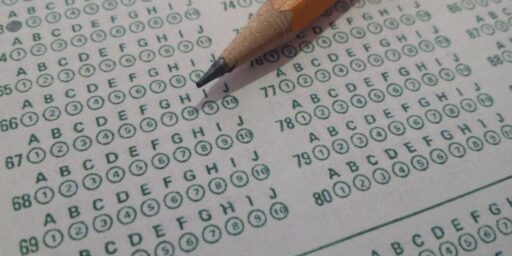AFFIRMATIVE ACTION REDUX
WaPo has an op-ed supporting racial discrimination in professional schools disguised as a news story:
According to the Association of American Medical Colleges, if its member schools relied strictly on academic measures for admissions, the proportions of black, Hispanic and Native American medical students would fall from the current 11 percent to no more than 3 percent. The situation is similar for the nation’s law schools, particularly highly selective ones, the Law School Admission Council said.
As the Supreme Court deliberates in two cases that challenge race-conscious admissions at the University of Michigan, attention has been focused on the potential impact on undergraduate education nationwide. But experts say the consequences could be worse for minority students who aspire to professional schools, where competition for seats is keener and alternatives are fewer.
“The best estimate that we have is that without race-conscious admissions, the number of African Americans in an entering class of 350 would fall below 10,” said Jeffrey S. Lehman, dean of Michigan’s law school. In the past decade, Michigan has enrolled 21 to 37 black first-year law students per class. “If there were a way to enroll more underrepresented minorities without considering race, we’d do it,” he said. “It is not that we like being race-conscious.”
So, unless standards–which the school has set–are lowered, very few minority students would get in. Why does that matter?
Medical school officials said that training black and Latino doctors is crucial not only for the sake of diversity but also to help ensure that there are medical professionals willing to practice in poor and minority communities, which are typically underserved by doctors. Numerous surveys of minority medical school graduates have found that they are far more interested in practicing in poor communities than other students.
“When you’re looking for medical students, there is a lot more to it than grade-point averages and test scores. Nobody has shown that the best doctor is necessarily the one with the best grade-point average and MCAT scores,” said Neil H. Parker, senior associate dean at UCLA medical school.
Really? Then why is that the way white and Asian students are selected? Why not go to a system–applied to students of all races–that does pick the best students? Further, if the goal is simply to get minority students degreed so they will serve in “their” communities, wouldn’t it make more sense for them to go to a lesser-tier school in their own community? Presumably, the point of going to a selective school like UCLA or Michigan is to join the profession’s elite and go on to commensurate careers. If your goal is to do community service, any decent school would suffice. Further, if we change the goal of these schools so that they are no longer elite, then racial discrimination is no longer necessary–just expand the class size to accomodate everyone who qualifies under the new, lower, standards. Or, if infrastructure issues prohibit that, simply decide what the class size will be and choose from all of the applicants who qualify based on the reduced standards via a lottery. That way, rather than having a school consisting of 90% “elite” students and 10% non-elite students who are clearly identifiable by race, no one will know who the dumb ones are other than by seeing how they perform in their classes.






Reverting back to a statement made during the Bakke case, “do you want the ‘quota-addmitted’ med student to become your brain surgeon?” !!
Oh, let the straw man alone. You know it’s steam control, I know it’s steam control, everyone knows it’s steam control. A simple cost of doing business in the face of an unendurable alternative.
There hasn’t been much discussion through the recent debates about minority admissions whether the commonly used admissions criteria are even meaningful. I seriously doubt that 10 or 20 points on the LSAT is in any way in the least bit relevant to whether one student is more capable than another.
Justice Scalia flirted with the edges of the meaningfulness of the criteria when he pointed out that admissions criteria began as a way for Ivy League schools to filter out Jews.
There are more than enough law schools for students who want to be lawyers and who have the ability to be able to go to law school. Which by the way brings up another point that hasn’t been discussed in the affirmative action debates. The handful of minority students who are being accepted to Harvard, Yale,Stanford and Michigan due to affirmative action are still highly qualified applicants who for the most part would be readily admitted without any special consideration by the still excellent schools a “tier down”. Those students are being bled off by the “top” schools, so the schools a tier down then also have affirmative action, and they bleed off the minority students from the next tier of schools.
By the way, does anyone seriously think that children of affluent educated professional parents don’t have a huge advantage every step of the way when it comes to admission to elite institutions? Could you possibly believe that that advantage derives from anything other than winning the random lottery of being born into a family with advantages? Isn’t affirmative action a way of protecting us against developing into a static society?
Are LSATs and such a perfect measure? No. But they’re treated as if they are for admissions for white students. If they’re not the best way, and a preferable alternative exists, then implement that system across the board.
There’s no doubt that the progeny of the wealthy have an advantage over the rest of us. However, while that correlates with race, it isn’t solved by a race-conscious admissions process. There are rich black people with children. Why should their kids have a double advantage–wealth plus racial preferences–over the children of middle class white parents?
Plus, elite institutions are FAR more diverse than they were, say, 40 years ago. Until fairly recently–before LSATs and such measures came into widespread usage–the elite institutions were almost entirely populated by the sons of the wealthy. Now, for white students at least, they are phenomenally meritocratic. Sure, poorer kids who aren’t exposed to the enviroment that comes from having parents and friends who are highly educated, are at a disadvantage still. But it’s a much lower one.
While I agree that racial quotas are a poor solution to what is essentially a non-problem, keep in mind that admission to a school doesn’t guarantee successful graduation from it. If these students are able to complete their education at the school with grades comparable to their peers, why are they any less able to work in their profession than someone who got the same grades but had 10% better entrance exam scores? I wonder what the graduation rate is for the students admitted under AA quotas?
For that matter, if test scores really mattered that much, shouldn’t institutions such as Kaplan or Test Prep Services be illegal because they unfairly boost scores?
At best academic testing is a gross way to filter out the supremely unqualified, but comparing numerical scores isn’t a good judge of how well that student will do in college or in the real world. That’s why few of the “elite” colleges rely solely on test scores but base their decisions on a wide range of criteria.
SSD: My understanding is that AA admits often don’t do all that well. But, really, that’s not the issue. The issue is the students who were denied admission to the more prestigious institution who were better qualified under the pre-set criteria. Again, if those are flawed, then change them. But do so across the board.
Not to mention that it is clearly unconstitutional for a state institution to discriminate on the basis of race; I’ve addressed that elsewhere, though.
Your argument that the WaPo is biased in favor of AA is unfounded. Both of your comments related directly to quotations from those interviewed by the paper. Unless you claim that the Post went out of its way to find people who would make pro-affirmative action statements (a dubious claim, given that the two people interviewed are exactly the people who should be interviewed for this story), it’s not the Post’s views on the issue that are being expressed.
Danny,
It’s not so much that the story was biased per se as the way it was treated. I haven’t seen the hard copy, so I might be misled by the website, but it appears to be given “front page” treatment. But there is no “news” in this story. The case has already been argued before the Court and there is nothing in the story that is new; these arguments have been made for years. It’s by definition true that if you take away a system that admits minority candidates that wouldn’t otherwise be admitted that you’ll have fewer minority students. Had a group come out with the argument that fewer smart white kids would get into school if the program were upheld, I dare to say it would not have been given the same prominence.
I’ll grant you that there’s not much that’s “newsworthy” in the story. But seeing as anti-affirmative action opinions are also granted equal space, your introduction stating that the “WaPo has an op-ed supporting racial discrimination in professional schools disguised as a news story” rings a bit hollow.
The other side is hardly given equal space. The lede and the first several paragraphs talk about the dire consequences of abandoning racial preferences in professional schools. Further, they’re cited as the authoritative analysis of experts. Then, a couple paragraphs stating that opponents, no credentials given, think diversity can be achieved without quotas. Then, immediately, “But achieving diversity through race-neutral means has proven much more difficult for professional schools” and then several more paragraphs supporting that position.
The reason they don’t want to use any of the alternative approaches that you suggest (such as a lottery, or school expansion) is that the anti-merit activists are really after a much bigger quarry. They want to use racial policies as a way of setting off racial conflict to the point that they (the anti-merit officials and their claque) can declare an emergency powers regime. If this were not the motivation then the alternative methods you mention , or one of them, or something like them, could be chosen. For more arguments of this sort, see the site at the screen name….
—